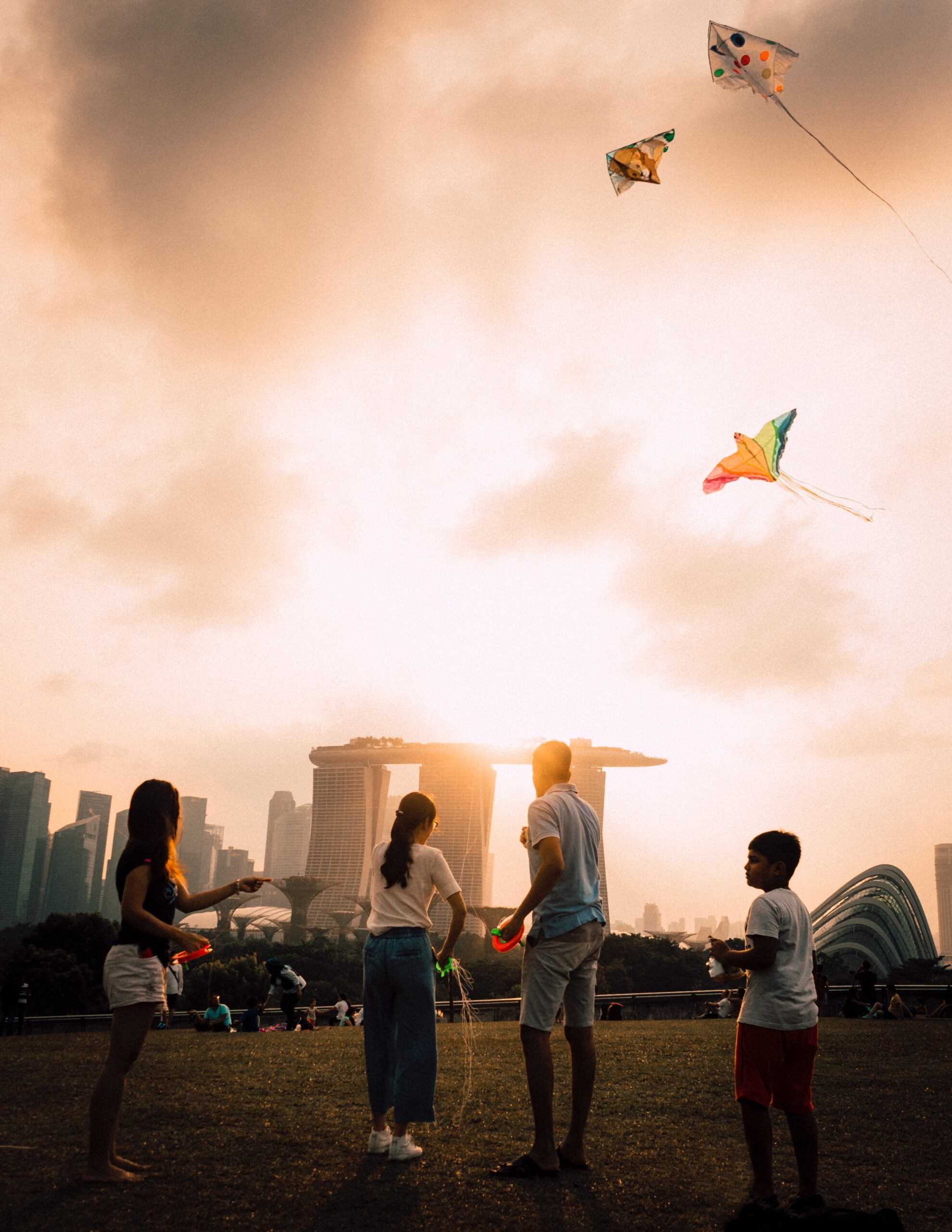Armchair Travel
Armchair travel refers to the experience of feeling like you’ve traveled by sitting in an armchair and enjoying travel books or TV programs. Although it’s become easier to travel abroad compared to the COVID-19 pandemic, many people are still unable to travel due to the unstable global situation and the depreciation of the yen. I hope to help those who can’t travel by sharing some imaginary trips.
For the first installment, I’ll be covering Singapore, a place I’ve visited multiple times and plan to visit again in February 2024.
アームチェアトラベルとは、肘掛け椅子に座って、旅行に関する本やテレビ番組を見て、旅行に行った気分になることを言います。
コロナ禍と比較すると、海外旅行には行きやすくなりましたが、それでも不安定な世界情勢、円安の影響で、まだまだ旅行に行けてない方に妄想旅のお手伝いをさせて頂けたらと思い、書き綴ります。
第一回で取り上げるのは、私自身が2024年2月に旅する予定で、
何度か訪れてるシンガポールです。
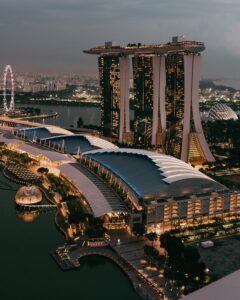
Basic Information About Singapore シンガポール基本情報
Climate
Located almost at the center of Southeast Asia, at 1 degree 17 minutes north latitude and 103 degrees 51 minutes east longitude, Singapore lies right on the equator and has no distinct seasons, remaining a tropical paradise year-round. The average annual temperature is around 26-27 degrees Celsius, with high heat and humidity. The rainy season runs from November to February, and the dry season from March to October. Many days see temperatures exceeding 30 degrees Celsius, and it doesn’t cool down much at night.
It’s summer all year round! It might be tough for those who can’t handle the heat. However, there is often a breeze, so the humidity might not feel as bad. A common piece of advice is to be mindful of the temperature difference between the indoors and outdoors, as air conditioning is often set to very low temperatures indoors. Therefore, it’s recommended to bring a light jacket with you to enjoy your trip comfortably.
気候
東南アジアのほぼ中心、赤道直下の北緯1度17分、東経103度51分に位置するシンガポールは四季がなく、一年中、常夏です。年間の平均気温は26〜27度で高温多湿。11〜2月が雨季、3〜10月が乾季となります。日中は30度を超える日が多く、夜間も気温はあまり下がりません。
一年中常夏!夏が駄目な人はきついかも。
ただ風があるので湿度はそこまででもないかも!?
よく言われてるのが、室内はクーラーがガンガンなので、外との気温差にご注意ください。なので羽織ものを一枚ご持参のうえで旅をお楽しみください。
Population
As of 2022, Singapore has a population of approximately 5.64 million people, of which 4.07 million are Singapore citizens and permanent residents. The ethnic composition is 74% Chinese, 14% Malay, and 9% Indian.
The Chinese community, often referred to as the Chinese diaspora, is notably successful in business, giving the impression of being highly capable and affluent.
人口
約564万人(うちシンガポール人・永住者は407万人)(2022年)
中華系74%、マレー系14%、インド系9%(2022年)
華僑と呼ばれる方々を中心にビジネスに長けた、優秀でお金持ちが多い印象です。
Language
The national language of Singapore is Malay. The official languages are English, Chinese, Malay, and Tamil.
While some people mock the accent known as “Singlish,” I personally believe that being able to speak more than one language is wonderful and deserves respect. In my experience, those who criticize accents often can’t speak English themselves.
言語
国語はマレー語。公用語として英語、中国語、マレー語、タミール語。
シングリッシュと揶揄され、そのなまりを馬鹿にする方々も一部おりますが、
私自身は、2カ国語以上話せるのは素晴らしいですし、リスペクトしております。
大抵、発音とかをいじってくる人たちは、そもそも英語話せない人が多い印象です。
Land
Singapore, with its limited natural resources and small land area, has prospered due to its advantageous geographical location, developing through trade. The country’s terrain is relatively flat and lacks significant water sources, necessitating the construction of numerous reservoirs and the importation of raw water from neighboring Malaysia to meet its water needs.
Singapore truly lacks distinctive local products. In the past, it was known for rubber trees, but now tourism might be considered its main “specialty.” To compare with Japan’s 47 prefectures, Singapore is often likened to the 23 wards of Tokyo or Awaji Island.
国土
資源など特になく、国土も狭いシンガポールですが、その地理的条件が幸いし、貿易で発展してきました。高低差の少ない狭い国土では水源に乏しいため、国内の多数の貯水池と隣国マレーシアからの輸入した原水で水の需要に応じてきました。
本当に特産物がなく、唯一、挙げるのであれば、昔はゴムの木で、今は観光でしょうか・・・日本の47都道府県に例えると,東京23区または、淡路島と言われています。
Food Culture
- In Singapore, it is common for both husband and wife to work. Most people do not cook at home and eat out for all three meals. In wealthy families, maids often do the shopping and cooking. Many Japanese people living in Singapore tend to cook at home.
- Singapore has a well-developed dining-out culture, with the food service industry being very advanced compared to other countries.
- Meals are often taken at 24-hour hawker centers (public food stalls) or food courts. These places offer affordable cuisine from around the world. However, they may not be very clean and have a unique atmosphere that people may either love or dislike.
- On average, households spend SGD 1,188 per month on food (approximately JPY 100,000, based on an exchange rate of SGD 1 = JPY 85), which accounts for a quarter of their total expenditure. Of this, 65% is spent on dining out.
- In households where both partners work, people prefer food that is quick to eat and rich in ingredients.
- Because sitting on tatami mats is uncomfortable for most Singaporeans, meals are not typically taken in this manner. Instead, they prefer tables or sunken kotatsu-style seating. Due to the large Chinese population, revolving tables (lazy Susans) are common.
- Different utensils are used depending on the type of food, such as chopsticks and soup spoons, or forks and spoons. It is considered improper to bring the dish to one’s mouth, so dishes are not lifted from the table.
- Making noise while eating soup or noodles is strictly prohibited.
- Coffee is a popular drink. Singaporeans prefer it sweet, often using a lot of sugar and cream. Iced coffee is not commonly consumed unless it’s from a well-known brand. Although cafes were rare in the past, cafe culture has recently started to take root. One popular cafe chain, “tcc,” with 28 locations in Singapore, opened its first store in Japan in Ginza, Tokyo, on February 16, 2015. If you have the chance, please visit.
- Smoking during meals is considered taboo.
食生活
・シンガポール人は基本夫婦共働きが多いです。
自炊はせず、3食外食することがほとんどである。富裕層の家庭ではメイドが買い物をし、料理をする。シンガポール在住の日本人は自炊する人が多い。
・外食文化が根付いているシンガポールでは、外食産業が他国と比べ、非常に発達している。
・食事は24時間営業のホーカーセンター(大衆屋台食堂)やフードコートですませることが多い。安価で世界各国の料理を味わうことができる。ただ、小奇麗とは言えず、独特の雰囲気で、好き嫌いは分かれそうです。
・家計における食費への支出は月額1,188Sドル(1Sドル=85円で計算、約10万円)で支出全体の1/4を占める。食費中の外食費の割合は65%にのぼる。
・共働き世帯の多いシンガポールでは、手間暇かけずにすぐに食べられ、具材の多いものが好まれる。
・正座やあぐらが苦手なため、畳の上での食事は好まれない。テーブルもしくは掘りごたつのほうがよい。中華系の人が多いので、中華の回転テーブルが主流。
・料理により箸とレンゲ、スプーンとフォークを使い分ける。
食器に口を直接つけることはタブーとされるため、食器をテーブルから持ち上げることはしない。
・スープや麺類など音を立ててすするのは厳禁である。
・コーヒーを好んで飲む。甘い味付けを好むため、砂糖やクリームを多く使う傾向がある。
・アイスコーヒーはよほど有名なブランドでない限り、飲む習慣がない。一昔前はカフェがほとんどなかったが、最近はようやく、カフェ文化が根づいてきた。シンガポールで28店舗を展開している人気カフェ「tcc」が、2015年2月16日、東京・銀座に日本初出店しているので、機会があれば、是非行ってみて下さい。
・食事中の喫煙はタブーとされている。
Singaporean Restaurants シンガポールレストラン
Singapore Hainanese Chicken Rice Suidobashi
Located near Tokyo Dome, this restaurant is a great spot to visit if you’re attending a baseball game! From the East Exit of JR Suidobashi Station, turn right and walk along Hakusan Street towards Jimbocho for about 5 minutes until you reach the Misakicho intersection.
The staff are Singaporean, ensuring an authentic dining experience. Even those who have lived in Singapore will find the taste satisfying. However, when I went on a weekend for lunch, there was a long line, and I couldn’t get in.
シンガポール海南鶏飯 水道橋店
https://tabelog.com/tokyo/A1310/A131003/13019447/
東京ドームの近くにあり、野球観戦に行くついでに立ち寄れるお店です!
JR水道橋駅東口を右に出て、白山通りを神保町方向に歩いて5分くらい、
三崎町交差点にあります。
店員がシンガポーリアンの方なので、本格的というかAuthentic(本場)です。
シンガポールに住んでいた方が訪れても、満足できる味をご堪能ください。
週末のお昼に行ったときは行列で入れませんでした・・・
SLOWJAM GARAGE Singaporean Cuisine Nakameguro (formerly known as Five Star Cafe)
This is one of my favorite restaurants. The authenticity is very high. The interior has an exotic atmosphere, making dining an enjoyable experience. However, due to the aging building, it closed in February 2020. It reopened along the Meguro River in January 2021. Despite the relocation, the taste and quality remained unchanged, so I highly recommend it!
SLOWJAM GARAGE Singaporean cuisine 中目黒【旧店名】ファイブスターカフェ
https://tabelog.com/tokyo/A1317/A131701/13255417/
私のお気に入りのお店です。再現性は高いです。
店内はエキゾチックな雰囲気で食事を楽しめ・・・たのですが、
建物の老朽化により2020年2月に閉店。2021年1月目黒川沿いに復活してます。
移転後も変わらぬ味付けとクオリティでしたので、お勧めです!
Singaporean Cuisine シンガポール料理
While I’ve introduced some great Singapore restaurants, you might be wondering what to eat there. What are the recommended dishes?
シンガポールレストランをご紹介したものの、
そもそも何を食べればよいのか?
何がお勧めなの?
バクテー(Bak kut teh / 肉骨茶)

Bak Kut Teh is a national dish of Singapore, alongside Chicken Rice. The name “肉骨茶” (Bak Kut Teh) is derived from the Hokkien dialect. This dish consists of pork spare ribs simmered with garlic and spices, resulting in incredibly tender meat that falls off the bone. The flavorful broth, infused with umami and a hint of pepper, is incredibly appetizing.
Bak Kut Teh is typically enjoyed with freshly steamed rice and “youtiao,” which are Chinese fried dough sticks. You can enhance the taste by pouring some of the broth over the rice with a ladle or placing the tender pork on top. The combination is simply perfect. The youtiao can be eaten as is, offering a dense texture, or soaked in the soup, where it absorbs the flavors and becomes soft and delicious. Choose your preferred way to enjoy it.
チキンライスに並ぶシンガポールの国民的メニュー。福建語に由来する漢字名は「肉骨茶」と書きます。豚肉のスペアリブをニンニクやスパイスとともに煮込んだ料理で、ホロホロくずれるお肉のやわらかさがたまりません。旨味に溢れたスープと、ほどよく効いた胡椒も、食欲をそそります。
バクテーは炊き立てのご飯や、「ヨウティヤオ」と呼ばれる中国風の揚げパンと一緒に食べます。ご飯の上にレンゲでスープをかけたり、骨からはずれた豚肉を載せて味わうと、相性抜群。細長い揚げパンを輪切りにしたものは、そのまま食べるとみっしりした食感ですが、スープに浸すと旨味が染みてソフトな食感になります。お好みの方をどうぞ。
フライド・ホッケン・ミー (Fried Hokkien mee / 炒福建面)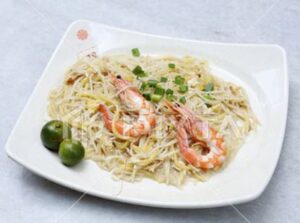
Fried Hokkien Mee, with the Chinese name “炒福建面,” is a seafood stir-fried noodle dish brought to Singapore by the people from the Fujian province. It is often considered one of the most appealing local foods to the Japanese palate. This dish is made by stir-frying yellow thick noodles (Hokkien mee) and rice vermicelli with shrimp, squid, and bean sprouts in a savory broth. Its light and flavorful taste makes it very popular.
When you order Fried Hokkien Mee, it usually comes with lime and chili sambal on the side. Squeeze the lime over the noodles and mix in a little chili sambal as you eat to enjoy a moderately spicy kick. Some food courts offer this dish in three sizes: S, M, and L. If you’re very hungry, go for M size or larger to satisfy your appetite.
福建地方の人々が伝えた海鮮焼きそばで、漢字名は「炒福建面」。シンガポールのローカルフードの中でも、日本人の味覚に最もマッチすると言われる料理です。塩味のダシでエビやイカやモヤシとともに麺を炒めており、あっさりしたおいしさが人気。麺は黄色の太麺(ホッケン・ミー)とビーフンを合わせたものを使っています。
フライド・ホッケン・ミーを頼むと、ライムとチリサンバルが付いてきます。塩味の効いた面の上にライムをしぼり、少しずつチリサンバルを混ぜながら食べると、ほどよく刺激的な味になります。フードコートではS・M・Lの3段階の量を設定しているところがあるので、お腹いっぱい食べたい人はMサイズ以上をどうぞ。
ラクサ(Laksa / 叻沙)

Laksa, a specialty of the Malay Peninsula region, originally comes from Nyonya cuisine. The soup base of Singaporean laksa typically features coconut milk. It includes thick rice vermicelli, shrimp, clams, fish cakes, fried tofu, and eggs.
The soup is slightly spicy due to the chili, but the coconut milk tempers the heat, resulting in an overall mild flavor. The rich broth pairs perfectly with the chewy texture of the rice vermicelli. Laksa stalls can be found in almost every hawker center and food court, making it an easily accessible Nyonya dish for travelers.
マレー半島周辺地域の名物料理であるラクサは、もとはといえばニョニャ料理です。シンガポールのラクサのスープは、ココナッツミルクをベースにしたものが中心。つるりとした太めのビーフンやエビ、貝、かまぼこ、揚げ豆腐、卵などの具がたっぷり入っています。
スープにはチリが入っているためややスパイシーですが、ココナッツミルクに緩和されて全体的にはマイルドな味わいです。濃厚なスープにもっちりした食感のビーフンが好相性。ラクサはどのホーカーズやフードコートにも必ずストールが入っているため、手軽に味わうことのできるニョニャ料理として、旅行者にも身近な存在です。
ロティ・プラタ(Roti Prata)
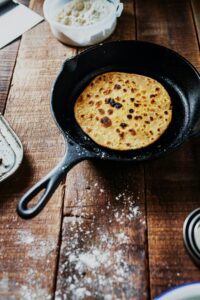
In simple terms, it’s similar to naan! Roti Prata is a crispy, round pancake that originated in South India, somewhat like a savory pancake or okonomiyaki. In Singapore, it’s called “Roti Prata,” while in Malaysia, it’s known as “Roti Canai.” The exterior is crispy and fragrant, while the inside is soft and chewy, offering a delightful contrast in textures. Besides plain roti prata, you can find a variety of options like egg prata, cheese prata, onion prata, and mushroom prata, making it a versatile dish.
Roti prata makers skillfully craft the dough into disc-shaped pancakes by slapping the dough onto the cooking board. The perfectly cooked prata is typically served with curry sauce or wrapped around curry ingredients. It pairs well with various curries, such as chicken curry, mutton curry, prawn curry, and vegetable curry.
簡単に言うとナンみたいなものです!サクサクしていて、南インドで生まれた丸いパンケーキ、あるいはお好み焼きのようなもの。シンガポールでは「ロティ・プラタ」、マレーシアでは「ロティ・チャナイ」と呼ばれています。表面は香ばしくてサクサク、中身はやわらかくてモチモチ。その食感のギャップがたまりません。プレーンなロティ・プラタの他に、エッグ・プラタ、チーズ・プラタ、オニオン・プラタ、マシュルーム・プラタなど、豊富な種類が揃っているのが魅力です。
プラタ職人は丸めた生地のかたまりを調理板に叩きつけながら、手際よく円盤状のパンケーキを作っていきます。こんがりと焼けたプラタには、カレーソースを付けたり、カレーの具を巻いて食べたりするのが一般的。チキン・カレー、マトン・カレー、えびカレー、ベジタブル・カレーなど、どんなカレーにもぴったり合いますよ。
Tourist Attractions 観光スポット
Once you’re full, it’s time to explore various attractions! Let me introduce you to some must-visit spots in Singapore.
お腹が満たされたのなら、次は様々な場所にお出掛けしましょう!
シンガポールの観光スポットをご案内します。
Universal Studios Singapore / Sentosa Island
ユニバーサル スタジオ シンガポール/セントーサ島

私は行ったことがありませんが、友人は入場料が高かったという、たった一言の感想でした(笑)ちなみに土日、祝日大人1人 75ドルです。デイズニーランドとさして変わらない気がしますが・・・
ただ、ユニバーサル スタジオがあるセントーサ島は、他にも様々な施設があり、ここでがっかりしても、どこかで挽回できるはずです。
世界的にも有名なテーマパークですので、内容は割愛します。
ちなみにハリーポッターはありません。
ガーデンズ バイ ザ ベイ/マリーナ・エリア
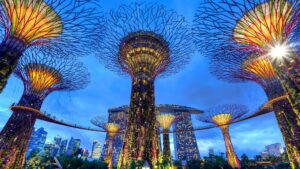
数年前に、初めて行きました。
壮大なスケールの植物園。おすすめです!
高度な技術を駆使して、地中海や南アフリカやカリフォルニアなどの、冷涼かつ乾燥した地域の春を再現した「フラワードーム」と映画の舞台のような「クラウド・フォレスト」の2つのガラスの巨大なドームがメインとなります。
他にも施設内には謎の浮かぶ巨大な赤ちゃんのオブジェやインドや中国の庭園、シンボルでもある高さ50mの人工の木「スーパーツリー」があります。スーパーツリーからは、園内だけでなくマリーナ・ベイ・サンズをはじめとする観光名所がぐるりと見渡せます。ロケーション抜群のこの植物園で、世界の樹木や花々のエネルギーに触れてみてください。
Sands SkyPark / Marina Bay Area
サンズ・スカイパーク/マリーナ・エリア
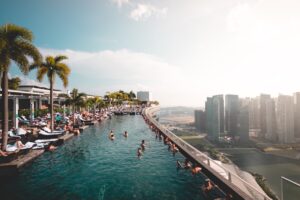
I have never been there myself!! However, the infinity pool here is world-famous, right? The members of SMAP once walked gracefully along this pool. It’s a breathtaking spot with panoramic views of Singapore’s cityscape.
The SkyPark offers various ways to take in the stunning skyline, whether you’re swimming in the pool or dining at one of the restaurants.
行ったことありません!!
ただ、世界的にもここにあるインフィニティ・プールは有名ですよね。
SMAPがここのプールを颯爽と歩いてました。
シンガポールの街並みを見渡せる絶景スポットです。
プールやレストランもあるので、色々な形でシンガポールのスカイラインを一望できます。
Merlion Park / Marina Bay Area
マーライオン公園/マリーナ・エリア
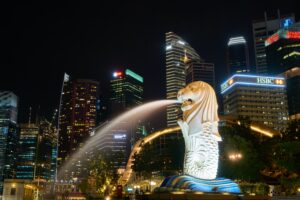
Clarke Quay / Clarke Quay Area クラーク・キー/クラーク・キー周辺
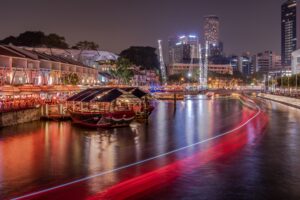
It’s my favorite place in Singapore. During the day, you can enjoy a pleasant walk along the riverside with a gentle breeze. At night, it transforms into a lively entertainment hotspot with picturesque views. For sightseeing, I recommend visiting from late afternoon to evening.
私が一番好きな場所です。
昼間は川沿いを心地よい風と共に歩けて、
夜は一気に盛り上がりを見せ、映えスポットに変貌する川沿いのエンタメスポットです。
観光するには、時間帯は夕方から夜がお薦めです。
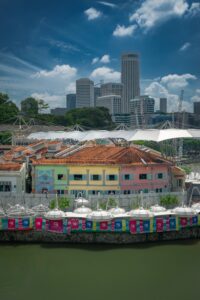
↑During the day, it looks like this. The river might not be the cleanest, but you can still enjoy a river cruise. The gentle breeze makes it a pleasant experience, and I highly recommend it!
↑昼間はこんな感じ。川汚い(笑)
川汚いですが、クルージングできます。そよ風が気持ちよくておすすめ!
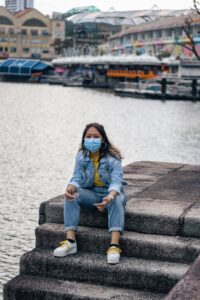
↑As you gaze at the river, take the opportunity to have a meaningful conversation with your friends or family
↑川を見つめながら、友達や家族で語らい合ってみてください。
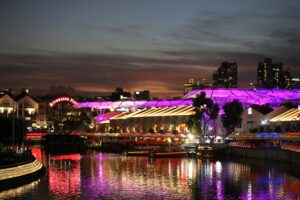
↑The daytime isn’t bad, but visiting at night might be more enjoyable. There are various restaurants and souvenir shops to explore. The place is filled with energetic people, making it perfect for nightlife activities.
↑昼間も悪くはないですが、訪れるのなら夜の方が楽しいかも。
様々なレストランやお土産屋さんがあります。
人々もエネルギッシュで夜遊びにはもってこいの場所です。
Orchard Road / Orchard Road Area オーチャード・ロード/オーチャード・ロード周辺
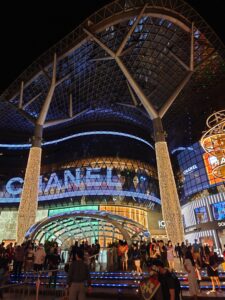
Orchard Road is a 2-kilometer-long shopping area that stretches through the heart of Singapore. Enjoy shopping in Singapore’s paradise for shoppers. However, do keep in mind that prices can be quite high..
オーチャードロードは、
シンガポールの中心街に2kmにわたって伸びるショッピングエリアです。
ショッピング天国・シンガポールで是非お買い物をお楽しみください。
物価は高いですが・・・
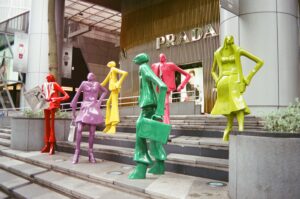
↑Stylish sculptures are found all over the place.
↑至る所にあるオブジェ。スタイリッシュ!?
Quiz
Final Quiz
Let’s wrap things up with a quiz! Please feel free to take on the challenge and submit your answers. Those who get the answers right might receive a souvenir from me when I visit Singapore next year!?
Since some of the information in this article might be a bit outdated, I’ll make sure to update it and post a follow-up after my trip to Singapore next year! Stay tuned and enjoy~♪
最後は、クイズで終わりにしたいと思います。
是非、チャレンジして頂いてご回答ください。
正解した方には、
私が来年シンガポールに行った際にお土産を買ってくるかもしれません!?
今回の記事は少し古い情報も含まれているかもしれないので、
来年シンガポールに行ったら、情報をupdateして、必ず続編をupします!
お楽しみに~♪
問題 Singapore is known for its strict laws and severe punishments, such as caning, which can be incredibly painful. Which of the following actions does NOT result in a fine?
シンガポールは法律が非常に厳しく、その刑罰も気絶するほど痛い鞭打ち等、震え上がるものが多いです。次のうち罰金にならないものはどれでしょうか?
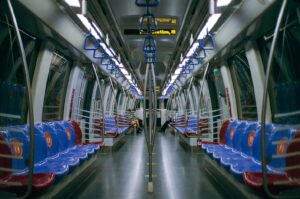
A. Eating or drinking on public transportation
B. Wandering around inside public transportation
C. Sleeping on public transportation
A.公共の乗り物内の飲食
B.公共の乗り物内でうろうろ歩き回る
C.公共の乗り物内で寝る
![]()

